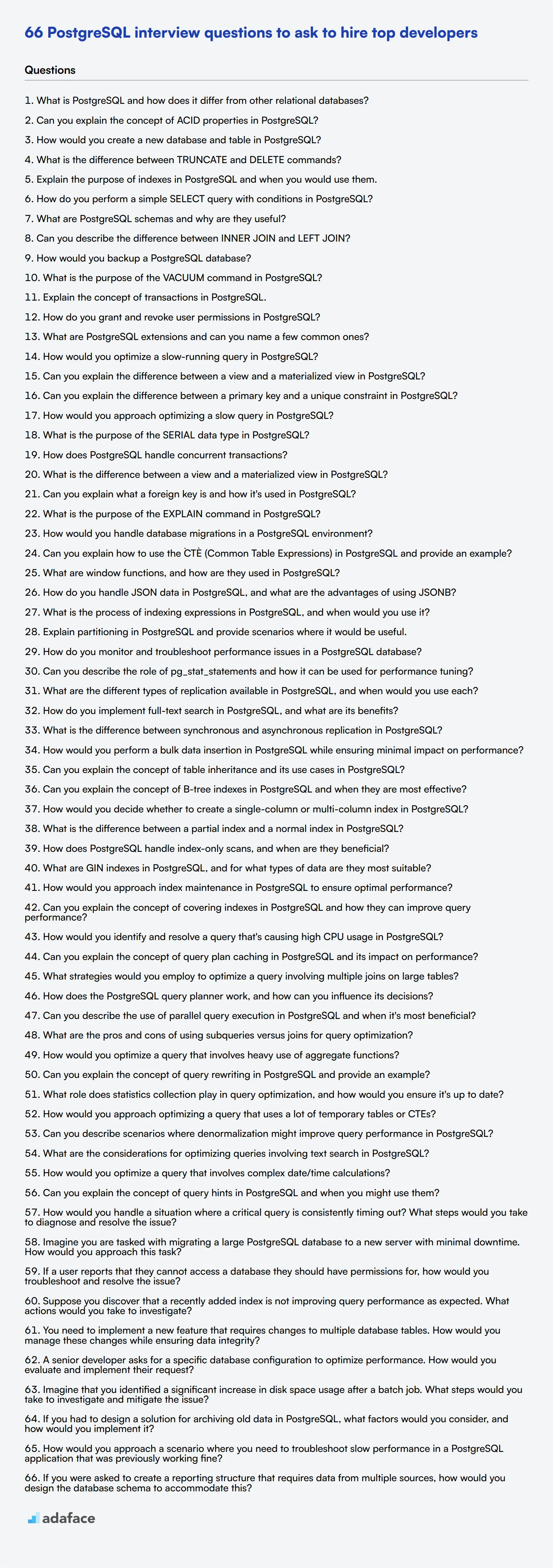Hiring the right PostgreSQL developer can make or break your database management and application performance. Asking the right interview questions is key to identifying candidates with the necessary skills and expertise to excel in your team.
This blog post provides a comprehensive list of PostgreSQL interview questions categorized by difficulty level and specific areas of focus. From basic concepts to advanced query optimization techniques, we cover everything you need to assess candidates effectively.
By using these questions, you can gain valuable insights into a candidate's PostgreSQL knowledge and problem-solving abilities. Consider complementing your interview process with a PostgreSQL skills test to get a more complete picture of your applicants' capabilities.
Table of contents
15 basic PostgreSQL interview questions and answers to assess applicants
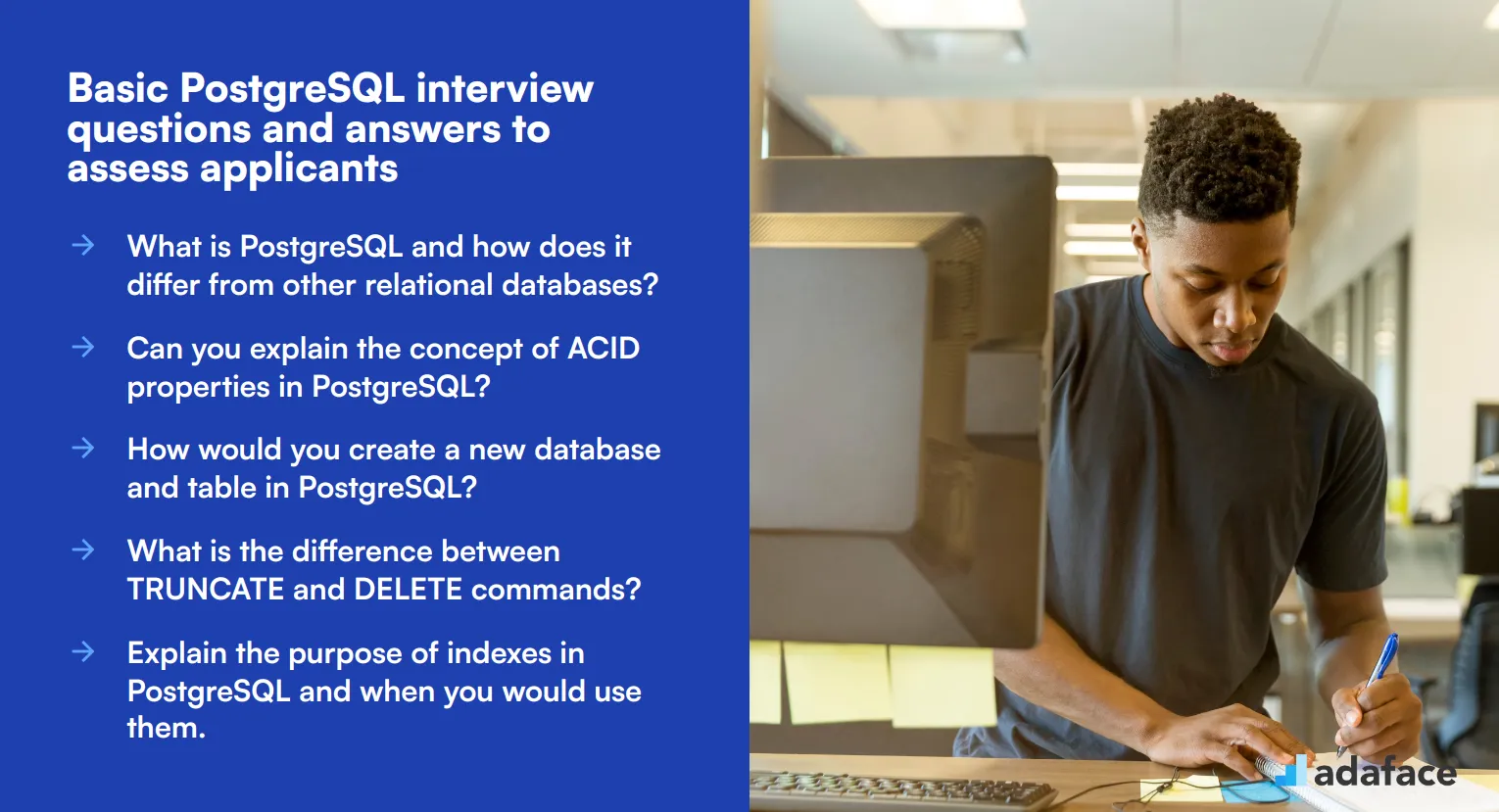
To effectively assess candidates for database developer roles, use these 15 basic PostgreSQL interview questions. These questions will help you gauge applicants' foundational knowledge and practical understanding of PostgreSQL, ensuring you identify candidates with the right skills for your team.
- What is PostgreSQL and how does it differ from other relational databases?
- Can you explain the concept of ACID properties in PostgreSQL?
- How would you create a new database and table in PostgreSQL?
- What is the difference between TRUNCATE and DELETE commands?
- Explain the purpose of indexes in PostgreSQL and when you would use them.
- How do you perform a simple SELECT query with conditions in PostgreSQL?
- What are PostgreSQL schemas and why are they useful?
- Can you describe the difference between INNER JOIN and LEFT JOIN?
- How would you backup a PostgreSQL database?
- What is the purpose of the VACUUM command in PostgreSQL?
- Explain the concept of transactions in PostgreSQL.
- How do you grant and revoke user permissions in PostgreSQL?
- What are PostgreSQL extensions and can you name a few common ones?
- How would you optimize a slow-running query in PostgreSQL?
- Can you explain the difference between a view and a materialized view in PostgreSQL?
8 PostgreSQL interview questions and answers to evaluate junior developers

Ready to put your junior PostgreSQL developers through their paces? These 8 interview questions will help you evaluate their foundational knowledge and problem-solving skills. While they won't require candidates to write complex queries on the spot, these questions will give you insight into their understanding of PostgreSQL's core concepts and their ability to apply them in real-world scenarios.
1. Can you explain the difference between a primary key and a unique constraint in PostgreSQL?
A primary key is a column or set of columns that uniquely identifies each row in a table. It automatically creates a unique index and cannot contain NULL values. A unique constraint, on the other hand, ensures that all values in a column or set of columns are distinct, but it can allow NULL values (unless specified otherwise).
When evaluating responses, look for candidates who can clearly articulate that primary keys are used to identify records uniquely and are often used as references in other tables, while unique constraints are used to ensure data integrity within a single table. A strong candidate might also mention that a table can have only one primary key but multiple unique constraints.
2. How would you approach optimizing a slow query in PostgreSQL?
To optimize a slow query in PostgreSQL, I would follow these steps:
- Use EXPLAIN ANALYZE to understand the query execution plan
- Check for missing indexes and add them where appropriate
- Rewrite the query to use more efficient JOIN conditions or subqueries
- Consider partitioning large tables if dealing with massive datasets
- Ensure statistics are up-to-date by running ANALYZE
- Look for opportunities to use materialized views for complex, frequently-run queries
A strong candidate should demonstrate a systematic approach to query optimization and show familiarity with PostgreSQL's performance tuning tools. Look for responses that prioritize understanding the query plan before making changes, as this indicates a thoughtful, data-driven approach to optimization.
3. What is the purpose of the SERIAL data type in PostgreSQL?
The SERIAL data type in PostgreSQL is used to create auto-incrementing integer columns. When you define a column as SERIAL, PostgreSQL automatically creates a sequence object and sets the default value of the column to the next value from this sequence.
This is commonly used for primary key columns where you want each new row to automatically get a unique identifier. It's important to note that SERIAL is not a true data type, but rather a shorthand notation for creating an integer column with a default value from a sequence.
Look for candidates who understand that SERIAL is a convenience feature and can explain its typical use cases. A strong response might also mention that SERIAL is equivalent to INT NOT NULL DEFAULT nextval('tablename_colname_seq') and discuss the implications for inserting rows or resetting the sequence.
4. How does PostgreSQL handle concurrent transactions?
PostgreSQL handles concurrent transactions using a multi-version concurrency control (MVCC) model. This approach allows multiple transactions to read and write data simultaneously without locking each other out. When a transaction modifies data, it creates a new version of that data, while other transactions can still read the old version.
The MVCC model ensures that:
- Readers don't block writers
- Writers don't block readers
- Each transaction sees a consistent snapshot of the database
A strong candidate should be able to explain that this approach eliminates the need for read locks and improves overall database performance. They might also mention isolation levels and how PostgreSQL uses them to balance consistency and performance. Look for responses that demonstrate an understanding of how MVCC impacts database design and query performance in real-world applications.
5. What is the difference between a view and a materialized view in PostgreSQL?
A view in PostgreSQL is a virtual table defined by a SELECT query. It doesn't store data itself but provides a way to encapsulate complex queries and present data in a simplified manner. Views are dynamically updated whenever the underlying data changes.
A materialized view, on the other hand, stores the result of a query physically. It's like a snapshot of the data at a specific point in time. Materialized views need to be refreshed manually or through a trigger to reflect changes in the underlying data.
When evaluating responses, look for candidates who can clearly articulate the trade-offs between views and materialized views. A strong answer might discuss scenarios where each type is more appropriate, such as using regular views for real-time data access and materialized views for improving query performance on complex, infrequently changing data sets. Candidates should also be aware that materialized views can significantly improve query performance but at the cost of data freshness and storage space.
6. Can you explain what a foreign key is and how it's used in PostgreSQL?
A foreign key in PostgreSQL is a column or group of columns in a table that references the primary key of another table. It establishes a link between two tables, ensuring referential integrity in the database. Foreign keys are used to enforce relationships between tables and prevent actions that would destroy these links.
When using foreign keys:
- The referenced table is called the parent table
- The table with the foreign key is called the child table
- Foreign keys can be used to create one-to-many, many-to-many, or one-to-one relationships between tables
Look for candidates who understand that foreign keys are crucial for maintaining data consistency across related tables. A strong response might include examples of how foreign keys are used in real-world database designs, such as linking orders to customers in an e-commerce system. Candidates should also be aware of the impact of foreign keys on insert, update, and delete operations, and how they can be used with cascading actions to maintain data integrity automatically.
7. What is the purpose of the EXPLAIN command in PostgreSQL?
The EXPLAIN command in PostgreSQL is used to display the execution plan of a query without actually executing it. It shows how the query planner intends to process the query, including information about table scans, join methods, and index usage.
Key points about EXPLAIN:
- It helps in understanding query performance
- It can be used to identify inefficient queries
- The ANALYZE option actually executes the query and provides real-time statistics
When evaluating responses, look for candidates who understand that EXPLAIN is a crucial tool for query optimization. A strong answer might include examples of how to interpret the output, such as recognizing when an index scan is preferable to a sequential scan. Candidates should also be aware that EXPLAIN ANALYZE provides more detailed information but actually runs the query, which can be important to consider for long-running or data-modifying queries.
8. How would you handle database migrations in a PostgreSQL environment?
Handling database migrations in PostgreSQL typically involves using a migration tool or framework to manage changes to the database schema over time. This process ensures that database changes are versioned, repeatable, and can be applied consistently across different environments.
A common approach to handling migrations includes:
- Writing migration scripts for each change (e.g., creating tables, adding columns)
- Versioning these scripts and storing them in version control
- Using a migration tool to apply or rollback changes
- Ensuring migrations are idempotent (can be run multiple times without side effects)
- Testing migrations in a staging environment before applying to production
Look for candidates who understand the importance of managing database schema changes systematically. A strong response might mention specific migration tools like Flyway or Alembic, and discuss strategies for handling complex migrations, such as data transformations or dealing with large tables. Candidates should also be aware of the challenges in coordinating database migrations with application deployments and how to minimize downtime during updates.
12 intermediate PostgreSQL interview questions and answers to ask mid-tier developers

To ensure your applicants can handle intermediate PostgreSQL tasks, use these questions to uncover their depth of knowledge and practical skills. These carefully curated questions will help you evaluate mid-tier developers effectively, much like a database developer job description outlines key responsibilities.
- Can you explain how to use the `CTE` (Common Table Expressions) in PostgreSQL and provide an example?
- What are window functions, and how are they used in PostgreSQL?
- How do you handle JSON data in PostgreSQL, and what are the advantages of using JSONB?
- What is the process of indexing expressions in PostgreSQL, and when would you use it?
- Explain partitioning in PostgreSQL and provide scenarios where it would be useful.
- How do you monitor and troubleshoot performance issues in a PostgreSQL database?
- Can you describe the role of pg_stat_statements and how it can be used for performance tuning?
- What are the different types of replication available in PostgreSQL, and when would you use each?
- How do you implement full-text search in PostgreSQL, and what are its benefits?
- What is the difference between synchronous and asynchronous replication in PostgreSQL?
- How would you perform a bulk data insertion in PostgreSQL while ensuring minimal impact on performance?
- Can you explain the concept of table inheritance and its use cases in PostgreSQL?
7 PostgreSQL interview questions and answers related to database indexing
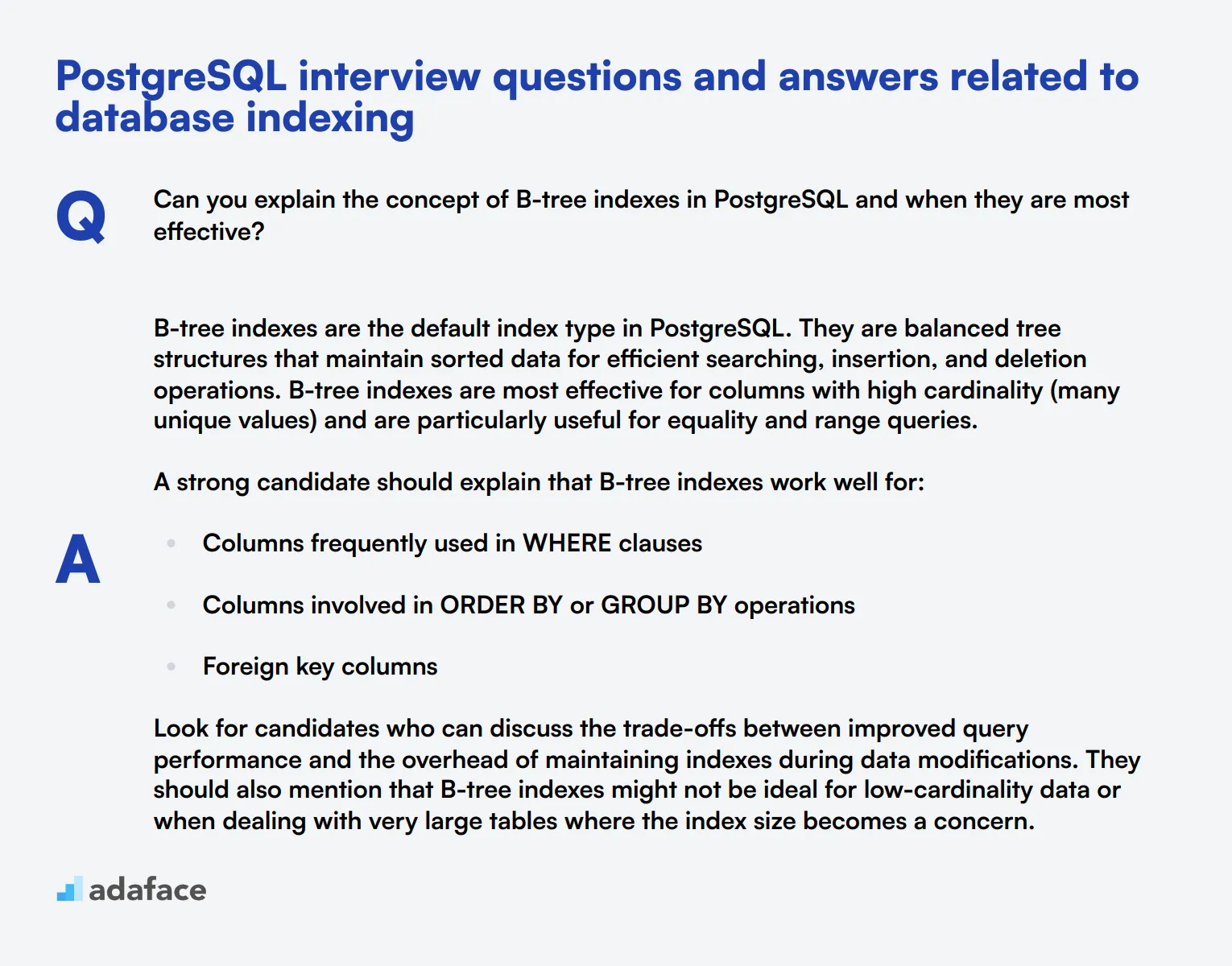
Ready to dive into the world of PostgreSQL indexing? These seven interview questions will help you assess a candidate's understanding of database indexing in PostgreSQL. Whether you're hiring a database developer or administrator, these questions will give you insight into their knowledge and problem-solving skills. Remember, the best candidates will not only provide correct answers but also demonstrate their ability to apply these concepts in real-world scenarios.
1. Can you explain the concept of B-tree indexes in PostgreSQL and when they are most effective?
B-tree indexes are the default index type in PostgreSQL. They are balanced tree structures that maintain sorted data for efficient searching, insertion, and deletion operations. B-tree indexes are most effective for columns with high cardinality (many unique values) and are particularly useful for equality and range queries.
A strong candidate should explain that B-tree indexes work well for:
- Columns frequently used in WHERE clauses
- Columns involved in ORDER BY or GROUP BY operations
- Foreign key columns
Look for candidates who can discuss the trade-offs between improved query performance and the overhead of maintaining indexes during data modifications. They should also mention that B-tree indexes might not be ideal for low-cardinality data or when dealing with very large tables where the index size becomes a concern.
2. How would you decide whether to create a single-column or multi-column index in PostgreSQL?
The decision between single-column and multi-column indexes depends on the query patterns and data distribution in the database. Single-column indexes are simpler and work well for queries that filter or sort by a single column. Multi-column indexes can be more efficient for queries that frequently use multiple columns in their WHERE clauses or for sorting.
A knowledgeable candidate should mention:
- Analyzing the most common and performance-critical queries
- Considering the selectivity of the columns
- Evaluating the trade-off between index size and query performance
- Using EXPLAIN ANALYZE to compare query plans with different index configurations
Look for candidates who understand that multi-column indexes are particularly useful when the leading column has low selectivity, but the combination of columns is highly selective. They should also be aware that the order of columns in a multi-column index is crucial for its effectiveness.
3. What is the difference between a partial index and a normal index in PostgreSQL?
A partial index in PostgreSQL is an index that is created on a subset of rows in a table, defined by a WHERE clause. In contrast, a normal index includes all rows in the table. Partial indexes are useful for improving query performance and reducing index size when you frequently query a specific subset of data.
Key points a strong candidate should mention:
- Partial indexes can significantly reduce index size and maintenance overhead
- They are particularly useful for columns with skewed data distribution
- Partial indexes can improve query performance for frequently accessed subsets of data
- They can be combined with other index types (e.g., B-tree, GiST)
Look for candidates who can provide examples of when to use partial indexes, such as indexing only active users in a user table or only recent orders in an order table. They should also understand that the query planner needs to match the WHERE clause of the query with the partial index definition for it to be used effectively.
4. How does PostgreSQL handle index-only scans, and when are they beneficial?
Index-only scans in PostgreSQL allow the database to retrieve the required data directly from the index without accessing the table. This is possible when all the columns needed for the query are included in the index. Index-only scans can significantly improve query performance by reducing I/O operations.
A knowledgeable candidate should explain:
- Index-only scans work with B-tree indexes
- They are most beneficial for queries that only need columns included in the index
- The visibility map helps determine which index entries are up-to-date
- INCLUDE clause can be used to add non-key columns to an index for index-only scans
Look for candidates who understand the trade-offs involved, such as increased index size when including additional columns. They should also be aware that index-only scans might not always be chosen by the query planner if the visibility map is not up-to-date or if the table is small enough that a sequential scan is faster.
5. What are GIN indexes in PostgreSQL, and for what types of data are they most suitable?
GIN (Generalized Inverted Index) indexes in PostgreSQL are designed for handling cases where multiple values are associated with a single row. They are particularly useful for indexing array columns, full-text search, and jsonb data types. GIN indexes store each element of an array or each token in a text document as a separate entry, allowing for efficient searching of specific values within these complex data types.
A strong candidate should mention:
- GIN indexes are excellent for "contains" queries on arrays
- They support full-text search when combined with text search configurations
- GIN indexes are beneficial for jsonb columns, especially for querying specific keys or values
- They can be slower to build and update compared to B-tree indexes, but offer faster searches
Look for candidates who can discuss the trade-offs between GIN and other index types, such as GiST. They should understand that while GIN indexes can be larger and slower to update, they provide faster search capabilities for complex data types. Candidates should also be aware of the maintenance considerations, such as the need for periodic VACUUM to manage index bloat.
6. How would you approach index maintenance in PostgreSQL to ensure optimal performance?
Index maintenance in PostgreSQL is crucial for maintaining optimal database performance. A comprehensive approach includes regular monitoring, analysis, and proactive management of indexes. This involves identifying unused or redundant indexes, rebuilding bloated indexes, and ensuring that indexes remain effective as data and query patterns change over time.
Key strategies a knowledgeable candidate should mention:
- Regularly running ANALYZE to update statistics used by the query planner
- Using VACUUM (or autovacuum) to reclaim space and update the visibility map
- Monitoring index usage with pg_stat_user_indexes to identify unused indexes
- Periodically rebuilding indexes with high bloat using REINDEX
- Reviewing and updating indexes based on changing query patterns
Look for candidates who understand the importance of balancing index maintenance with database performance. They should be able to discuss how to schedule maintenance tasks during low-traffic periods and the benefits of using database administrator tools for monitoring and automating index maintenance tasks. Strong candidates will also mention the need to consider the impact of index maintenance on replication and backup processes.
7. Can you explain the concept of covering indexes in PostgreSQL and how they can improve query performance?
Covering indexes in PostgreSQL, also known as indexes with INCLUDE columns, are indexes that contain all the data required to satisfy a query without needing to access the table. They are created by adding non-key columns to an index using the INCLUDE clause. This allows for index-only scans on queries that need data from both the indexed columns and the included columns.
A strong candidate should explain:
- Covering indexes can significantly reduce I/O by eliminating table lookups
- They are particularly useful for queries that frequently access a small subset of columns
- The INCLUDE clause allows adding columns to the index without affecting the B-tree structure
- Covering indexes can be larger than standard indexes due to the additional data
Look for candidates who can discuss the trade-offs between query performance improvement and increased index size and maintenance overhead. They should be able to provide examples of when covering indexes are most beneficial, such as in reporting queries or frequently accessed summary data. Strong candidates will also mention that careful analysis of query patterns is necessary to determine the optimal set of columns to include in a covering index.
14 PostgreSQL questions related to query optimization
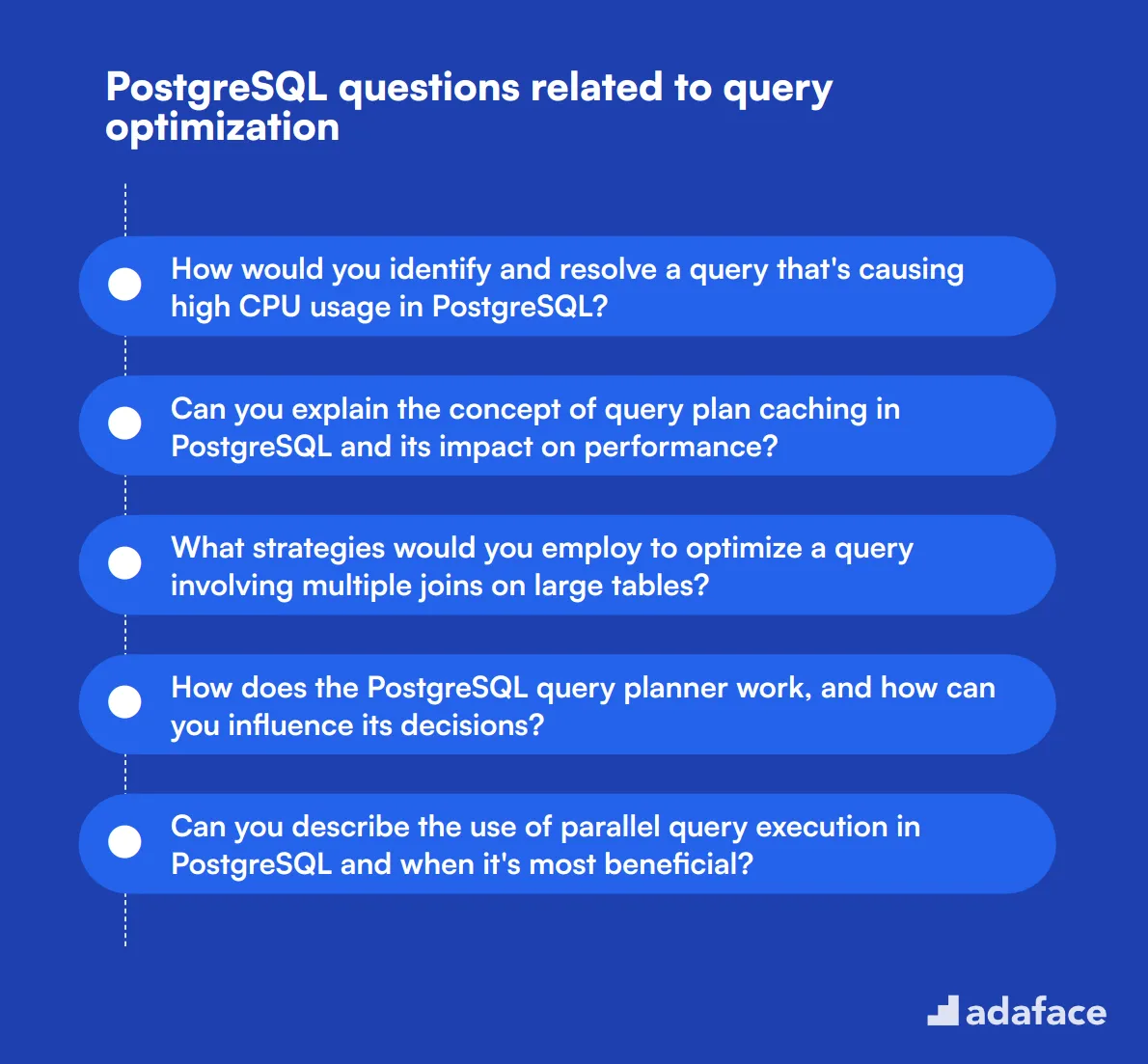
To assess a candidate's proficiency in query optimization, consider using these 14 PostgreSQL interview questions. These questions are designed to evaluate an applicant's ability to enhance database performance and efficiency, crucial skills for any database professional.
- How would you identify and resolve a query that's causing high CPU usage in PostgreSQL?
- Can you explain the concept of query plan caching in PostgreSQL and its impact on performance?
- What strategies would you employ to optimize a query involving multiple joins on large tables?
- How does the PostgreSQL query planner work, and how can you influence its decisions?
- Can you describe the use of parallel query execution in PostgreSQL and when it's most beneficial?
- What are the pros and cons of using subqueries versus joins for query optimization?
- How would you optimize a query that involves heavy use of aggregate functions?
- Can you explain the concept of query rewriting in PostgreSQL and provide an example?
- What role does statistics collection play in query optimization, and how would you ensure it's up to date?
- How would you approach optimizing a query that uses a lot of temporary tables or CTEs?
- Can you describe scenarios where denormalization might improve query performance in PostgreSQL?
- What are the considerations for optimizing queries involving text search in PostgreSQL?
- How would you optimize a query that involves complex date/time calculations?
- Can you explain the concept of query hints in PostgreSQL and when you might use them?
10 situational PostgreSQL interview questions for hiring top developers

To evaluate whether your candidates have the ability to handle real-world challenges in PostgreSQL, consider using these situational interview questions. They are designed to bring out practical skills and problem-solving capabilities, making it easier to identify top talent in your team for positions like database developer.
- How would you handle a situation where a critical query is consistently timing out? What steps would you take to diagnose and resolve the issue?
- Imagine you are tasked with migrating a large PostgreSQL database to a new server with minimal downtime. How would you approach this task?
- If a user reports that they cannot access a database they should have permissions for, how would you troubleshoot and resolve the issue?
- Suppose you discover that a recently added index is not improving query performance as expected. What actions would you take to investigate?
- You need to implement a new feature that requires changes to multiple database tables. How would you manage these changes while ensuring data integrity?
- A senior developer asks for a specific database configuration to optimize performance. How would you evaluate and implement their request?
- Imagine that you identified a significant increase in disk space usage after a batch job. What steps would you take to investigate and mitigate the issue?
- If you had to design a solution for archiving old data in PostgreSQL, what factors would you consider, and how would you implement it?
- How would you approach a scenario where you need to troubleshoot slow performance in a PostgreSQL application that was previously working fine?
- If you were asked to create a reporting structure that requires data from multiple sources, how would you design the database schema to accommodate this?
Which PostgreSQL skills should you evaluate during the interview phase?
While a single interview may not unveil every aspect of a candidate's capabilities, focusing on key PostgreSQL skills can significantly streamline the assessment process. Highlighting these skills ensures you target what's most relevant for roles involving this robust database management system.
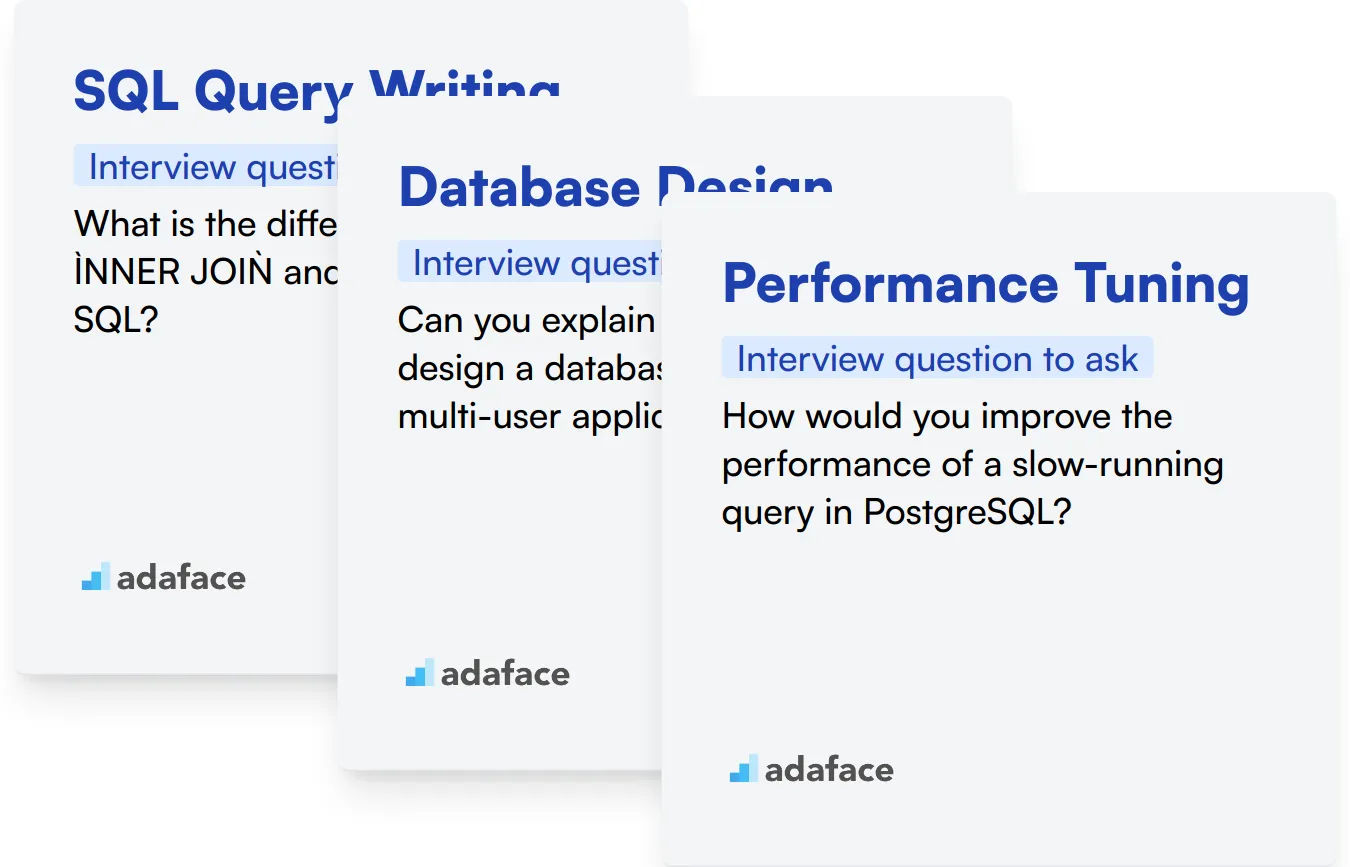
SQL Query Writing
The ability to write efficient SQL queries is the backbone of effective database management. This skill ensures that a developer can retrieve, manipulate, and analyze data swiftly, making it a direct indicator of their proficiency with PostgreSQL.
To effectively gauge a candidate's SQL skills, consider utilizing a SQL Online Test. This test comprises relevant MCQs designed to assess various aspects of SQL knowledge, ensuring a comprehensive evaluation.
For a deeper insight into their query writing skills, pose the following question during the interview:
What is the difference between INNER JOIN and OUTER JOIN in SQL?
Look for a clear understanding of how different joins affect query results and performance. A proficient candidate will not only define each but also provide scenarios where one might be preferred over the other.
Database Design
Database design is critical as it impacts the scalability and performance of applications. A well-designed database ensures data integrity and optimization, which are crucial for any PostgreSQL-based system.
To assess their capabilities in database design, ask them:
Can you explain how you would design a database schema for a multi-user application?
The candidate’s answer should reflect a thoughtful approach to aspects like normalization, data types, and indexing, indicating their depth of understanding in structuring a PostgreSQL database effectively.
Performance Tuning
Performance tuning is essential in managing databases as it directly influences the efficiency of data retrieval and resource utilization. Mastery in this area signifies a candidate’s ability to optimize PostgreSQL environments.
Evaluate their knowledge of performance tuning by asking:
How would you improve the performance of a slow-running query in PostgreSQL?
Desirable answers should include techniques such as indexing, query rewriting, or configuration changes. This response demonstrates their problem-solving skills and practical knowledge of PostgreSQL optimization.
Tips for Conducting Effective PostgreSQL Interviews
Before putting your PostgreSQL interview questions to use, consider these tips to maximize the effectiveness of your hiring process.
1. Implement Skills Tests Prior to Interviews
Using skills tests before interviews can help you filter candidates more effectively. This approach saves time and ensures you're interviewing the most qualified applicants.
For PostgreSQL roles, consider using a PostgreSQL test to evaluate technical proficiency. You might also want to include a SQL coding test to assess practical skills.
These tests can provide objective data on a candidate's abilities. Use the results to tailor your interview questions and focus on areas that need further exploration.
2. Prepare a Balanced Set of Interview Questions
With limited interview time, it's crucial to ask the right questions. Aim for a mix of technical PostgreSQL questions and those that assess other relevant skills.
Consider including questions about database design, query optimization, and data modeling. You might also want to explore the candidate's knowledge of related technologies like ETL processes or data warehousing.
Don't forget to assess soft skills such as problem-solving and communication. These are equally important for a PostgreSQL developer's success in your team.
3. Ask Insightful Follow-up Questions
Prepared questions are a good start, but follow-up questions can reveal a candidate's true depth of knowledge. They help you distinguish between memorized answers and genuine understanding.
For example, if you ask about indexing in PostgreSQL, a follow-up might be, "Can you describe a situation where adding an index might not improve query performance?" This probes the candidate's practical experience and problem-solving skills.
Use PostgreSQL interview questions and skills tests to hire talented developers
If you're looking to hire someone with PostgreSQL skills, it's essential to ensure they possess the right expertise. The best way to do this is by using skills tests such as the PostgreSQL Test, SQL Online Test, or the Data Engineer Test.
Once you have used these tests, you can shortlist the best applicants and invite them for interviews. To proceed, you can sign up here or check out our online assessment platform for more details.
PostgreSQL Online Test
Download PostgreSQL interview questions template in multiple formats
PostgreSQL Interview Questions FAQs
Focus on their understanding of database concepts, query optimization, indexing, and practical problem-solving skills.
Use situational and practical questions that require candidates to write or optimize actual queries.
Avoid asking overly theoretical questions and ensure your questions are relevant to the job role.
While specific version experience can be beneficial, focus more on overall proficiency with PostgreSQL concepts and tools.
They are crucial as they directly impact database performance. Assess candidates' understanding of these topics thoroughly.
Yes, including practical tasks can help you gauge a candidate's real-world skills and problem-solving approach.

40 min skill tests.
No trick questions.
Accurate shortlisting.
We make it easy for you to find the best candidates in your pipeline with a 40 min skills test.
Try for freeRelated posts
Free resources




